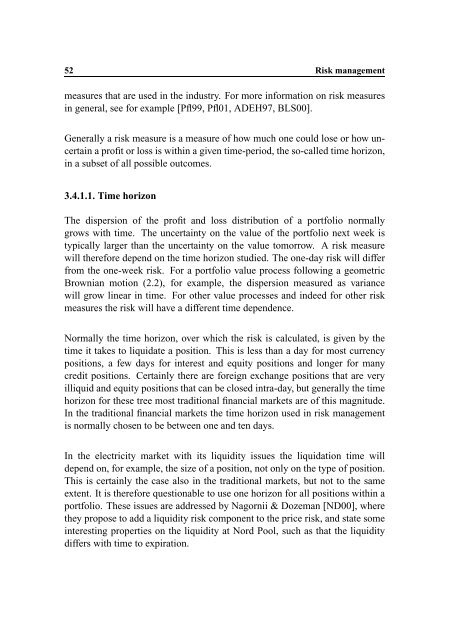Hedging Strategy and Electricity Contract Engineering - IFOR
Hedging Strategy and Electricity Contract Engineering - IFOR
Hedging Strategy and Electricity Contract Engineering - IFOR
You also want an ePaper? Increase the reach of your titles
YUMPU automatically turns print PDFs into web optimized ePapers that Google loves.
52 Risk management<br />
measures that are used in the industry. For more information on risk measures<br />
in general, see for example [Pfl99, Pfl01, ADEH97, BLS00].<br />
Generally a risk measure is a measure of how much one could lose or how uncertain<br />
a profit or loss is within a given time-period, the so-called time horizon,<br />
in a subset of all possible outcomes.<br />
3.4.1.1. Time horizon<br />
The dispersion of the profit <strong>and</strong> loss distribution of a portfolio normally<br />
grows with time. The uncertainty on the value of the portfolio next week is<br />
typically larger than the uncertainty on the value tomorrow. A risk measure<br />
will therefore depend on the time horizon studied. The one-day risk will differ<br />
from the one-week risk. For a portfolio value process following a geometric<br />
Brownian motion (2.2), for example, the dispersion measured as variance<br />
will grow linear in time. For other value processes <strong>and</strong> indeed for other risk<br />
measures the risk will have a different time dependence.<br />
Normally the time horizon, over which the risk is calculated, is given by the<br />
time it takes to liquidate a position. This is less than a day for most currency<br />
positions, a few days for interest <strong>and</strong> equity positions <strong>and</strong> longer for many<br />
credit positions. Certainly there are foreign exchange positions that are very<br />
illiquid <strong>and</strong> equity positions that can be closed intra-day, but generally the time<br />
horizon for these tree most traditional financial markets are of this magnitude.<br />
In the traditional financial markets the time horizon used in risk management<br />
is normally chosen to be between one <strong>and</strong> ten days.<br />
In the electricity market with its liquidity issues the liquidation time will<br />
depend on, for example, the size of a position, not only on the type of position.<br />
This is certainly the case also in the traditional markets, but not to the same<br />
extent. It is therefore questionable to use one horizon for all positions within a<br />
portfolio. These issues are addressed by Nagornii & Dozeman [ND00], where<br />
they propose to add a liquidity risk component to the price risk, <strong>and</strong> state some<br />
interesting properties on the liquidity at Nord Pool, such as that the liquidity<br />
differs with time to expiration.
















